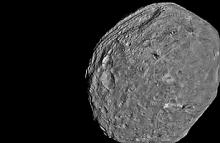There are two high-profile NASA probes in the big black, and one of them has just made an important stop. Having successfully entered the orbit of the second largest asteroid in our solar system, the Dawn Probe is settling in to begin mapping the asteroid and answering some questions about one of the largest "breeders" of Earth-bound meteorites of which we know. As reported on TIME.com, settling any space vessel into a planetary object's orbit is a tricky maneuver and anything but guaranteed. When the Dawn Probe completed it's entrance and settled into the asteroid's gravity field, scientists celebrated, and then got down to the business of making discoveries.
Vesta, an enormous body floating toward the outside of the solar system's asteroid belt, is an oblate spheroid (a flattened ball) and represents nearly 1/10th of the mass of the entire asteroid belt. It's roughly the size of Arizona at 350 miles across. Asteroids in our belt are considered to be one of two kinds, either pieces of planet or other asteroids that broke off in collisions, or detritus that was never absorbed into a planetary body when our solar system initially congealed billions of years ago. Which kind Vesta is will be one of the findings to which scientists home to come. Initial pictures from Dawn show two parallel grooves flanking Vesta's equator, which are evidence, claims Chris Russell of UCLA, Dawn's chief investigator, of a massive object having slammed into the asteroid's south pole eons ago. "A nearly body-shattering event," Russell elaborates. This also explains the proliferation meteorites that are believed to have originated from Vesta, about 5% of all meteorites that fall to Earth.
After a mapping run of Vesta next week, Dawn will move on to Ceres, the closest dwarf planet to Earth. New Horizons, meanwhile, will continue on to the solar system's newest (and largest) dwarf planet, Pluto. In 2006, when both probes were launched, Pluto was still classified as a full-blown planet. When the International Astronomical Union demoted Pluto to dwarf-planet status, Ceres was upgraded as well, from asteroid to dwarf planet. Ceres, resting as it does in the asteroid belt, was labeled an asteroid because of its "guilt by association". When the body was initially discovered in 1801, astronomers were attempting to find planets in the mysterious gap between mars and Jupiter (which we now know contains an enormous asteroid belt). They called Ceres a planet at that point, but soon found dozens of other bodies as big as Ceres. Worried that they were filling the solar system with too many planets, they applied a blanket downgrade to all bodies in the band with the label "asteroid".
Dawn will arrive at Ceres in 2014, where scientists believe there is a good chance they may find frozen water (as with Jupiter's moon Europa, and Saturn's Enceladus). Finding water throughout our solar system is important for several reason, not the least of which is future exploration. As we continue to work toward manned exploration to these far off landmarks, it's necessary to find that basic life-giving compound along the way; like desert explorers moving from oasis to oasis. In 2015 New Horizons is scheduled to arrive at Pluto, and the mapping of the largest bodies of our solar system will conceivably be complete.
